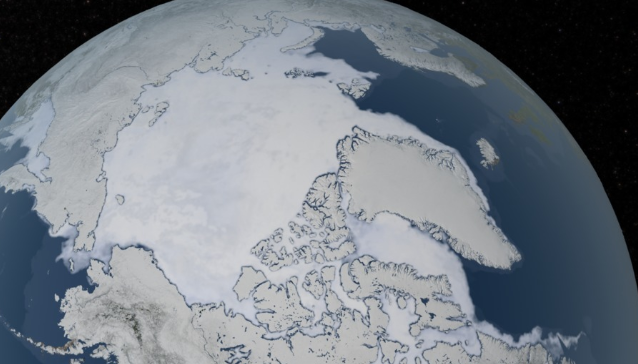
Researchers from Aarhus University, in collaboration with Stockholm University and the United States Geological Survey, analyzed samples from the previously inaccessible region north of Greenland. The sediment samples were collected from the seabed in the Lincoln Sea. They showed that the sea ice in this region melted away during summer months around 10,000 years ago.
The research team concluded that summer sea ice melted at a time when temperatures were higher than today.
"Climate models have suggested that summer sea ice in this region will melt in the coming decades, but it's uncertain if it will happen in 20, 30, 40 years, or more. This project has demonstrated that we're very close to this scenario, and that temperatures only have to increase a little before the ice will melt," says Christof Pearce, Assistant Professor at the Department of Geoscience, Aarhus University.
Comment: Except all signs point to a cooling planet: Two icebreakers sent to rescue TWENTY ice-locked ships on Northern Sea Route in the Arctic
Summer temperatures higher than today
The researchers have used data from the Early Holocene period to predict when the sea ice will melt today. During this time period, summer temperatures in the Arctic were higher than today. Although this was caused by natural climate variability opposed to the human-induced warming, it still is a natural laboratory for studying the fate of this region in the immediate future.
In Aarhus the marine samples have been analyzed in collaboration with Associate Professor Marianne Glasius and academic technical staff Mads Mørk Jensen from the Department of Chemistry. Among other things, they studied molecules from certain algae that are only produced when there is sea ice. The researchers can thereby determine when summer sea ice was present in the area.
When the sea ice in the Lincoln Sea begins to melt during the summer months, it can have major consequences for the climate. Where white ice reflects the rays of the sun, a dark sea will absorb more than ten times as much solar energy.
"The sea ice is a base for many ecosystems. The algae we examined are food for fish, fish are food for birds, etc. How will the marine ecosystems be affected globally if the sea ice disappears? We don't know the answer yet," says Henrieka Detlef, an assistant professor at the Department of Geoscience.
According to the researchers from Aarhus University, the study can be interpreted as bad news and good news for the climate. Henrieka Detlef also said that if temperatures remain stable or perhaps even fall, "the sea ice would return to the area."
Alarmist authors
Despite the undisputed powerful natural factors and cycles at play in the Arctic, some researchers take a more alarmist or even hysterical view of what the future holds. For example, warning that greenhouse gas emissions are heating up the planet, Christof Pearce said, citing dubious model results: "The study is a wake-up call, because we know that it will happen. This news is not making the situation more depressing, just more urgent. We have to act now so we can change it."
The research is published in the journal Communications Earth & Environment, and presented using an alarmist narrative. The study's results indeed confirm natural factors were at play during the early Holocene, and thus readers need to keep in mind that these natural factors have not gone away. They continue to change and drive our climate today.
Henrieka Detlef et al, Seasonal sea-ice in the Arctic's last ice area during the Early Holocene, Communications Earth & Environment (2023). DOI: 10.1038/s43247-023-00720-w



I think this guy got it: [Link]